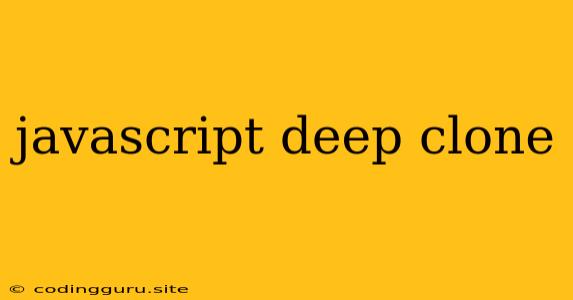Deep Cloning in JavaScript: Why and How?
In the world of JavaScript, manipulating data is a constant dance. But sometimes, you need more than just a reference to your original object – you need a completely independent copy. This is where the concept of deep cloning comes in.
Imagine you have a complex object, perhaps representing a user profile with nested properties like addresses, friends, and hobbies. Simply assigning this object to a new variable doesn't create a separate copy; it just creates a new reference to the same object. Changes made to either variable would affect the other. This can lead to unexpected and potentially disastrous behavior, especially in scenarios where you're manipulating data across different parts of your application.
That's where deep cloning steps in. It creates a true copy of an object, including all its nested objects and arrays, ensuring that any changes you make to the clone won't impact the original.
Why Choose Deep Cloning?
Here's why deep cloning is a powerful technique:
- Data Integrity: Protects your original data from accidental modifications.
- Data Sharing: Allows you to safely pass copies of objects to different parts of your application without fear of interference.
- State Management: Useful in state management libraries like Redux, where you want to maintain a clean separation between the application state and its modifications.
- Testing: Facilitates testing by providing isolated copies of objects for each test scenario.
How to Deep Clone in JavaScript?
There are several ways to achieve deep cloning in JavaScript:
1. JSON.parse(JSON.stringify(obj)):
This is the most straightforward approach. It stringifies the object using JSON.stringify(), then parses it back into a new object using JSON.parse(). This method handles basic data types like strings, numbers, and arrays effectively.
Example:
const originalObject = {
name: "John Doe",
age: 30,
address: {
street: "123 Main St",
city: "Anytown",
},
};
const deepClone = JSON.parse(JSON.stringify(originalObject));
deepClone.address.city = "Newtown"; // This won't affect the originalObject
console.log(originalObject); // { name: "John Doe", age: 30, address: { street: "123 Main St", city: "Anytown" } }
console.log(deepClone); // { name: "John Doe", age: 30, address: { street: "123 Main St", city: "Newtown" } }
2. Recursive Function:
For more complex scenarios with nested objects, a recursive function can be implemented. This approach traverses the object structure, copying each property recursively.
Example:
function deepClone(obj) {
if (typeof obj !== 'object' || obj === null) {
return obj;
}
let clone = Array.isArray(obj) ? [] : {};
for (let key in obj) {
clone[key] = deepClone(obj[key]);
}
return clone;
}
const originalObject = {
name: "John Doe",
age: 30,
address: {
street: "123 Main St",
city: "Anytown",
},
};
const deepClone = deepClone(originalObject);
deepClone.address.city = "Newtown"; // This won't affect the originalObject
console.log(originalObject); // { name: "John Doe", age: 30, address: { street: "123 Main St", city: "Anytown" } }
console.log(deepClone); // { name: "John Doe", age: 30, address: { street: "123 Main St", city: "Newtown" } }
3. Libraries:
For even more advanced deep cloning scenarios or handling circular references, you can leverage external libraries like lodash or underscore:
Example using Lodash:
const _ = require('lodash');
const originalObject = {
name: "John Doe",
age: 30,
address: {
street: "123 Main St",
city: "Anytown",
},
};
const deepClone = _.cloneDeep(originalObject);
deepClone.address.city = "Newtown"; // This won't affect the originalObject
console.log(originalObject); // { name: "John Doe", age: 30, address: { street: "123 Main St", city: "Anytown" } }
console.log(deepClone); // { name: "John Doe", age: 30, address: { street: "123 Main St", city: "Newtown" } }
Considerations
While deep cloning provides significant benefits, remember:
- Performance: For deeply nested objects, deep cloning can be computationally expensive. Use it strategically and consider alternatives like shallow cloning for simpler cases.
- Circular References: Be mindful of circular references in your objects. If you have objects that reference each other, deep cloning can lead to infinite recursion. Some libraries, like
lodash, handle circular references intelligently. - Date Objects: Note that
JSON.stringifyandJSON.parseconvertDateobjects to strings. If you need to preserve date objects, you might need to implement custom logic for handling them during the cloning process.
Conclusion
Deep cloning is a powerful tool for handling complex data structures in JavaScript. By understanding its purpose and various implementation methods, you can choose the right approach to ensure data integrity and maintain a clean separation of data within your applications. Whether you're working with simple objects, deeply nested structures, or dealing with circular references, deep cloning helps you confidently manipulate your data without unintended side effects.
